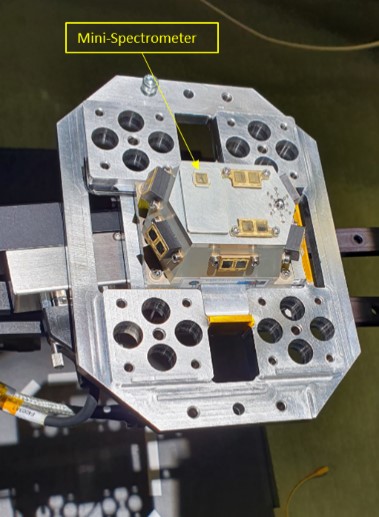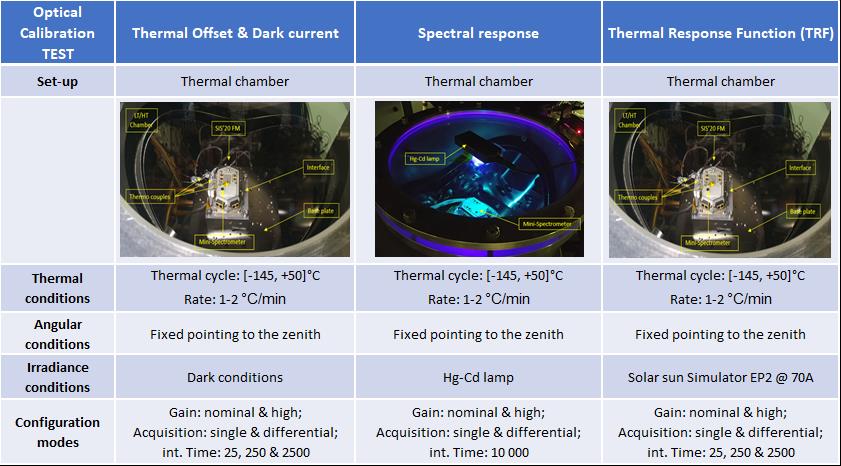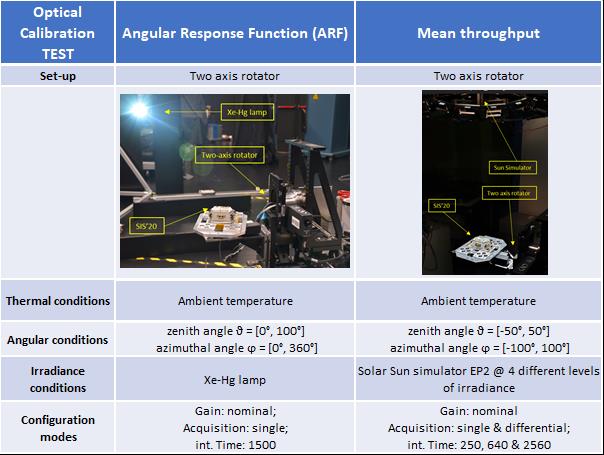Optical Calibration procedure and results of the mini-spectrometer from the Solar Irradiance Sensor (SIS) radiometer for the ExoMars’22 mission
- 1Instituto Nacional de Técnica Aeroespacial, INTA, Ajalvir Road 4.2 Km, Torrejon de Ardoz, 280850 Madrid, Spain (garciamee@inta.es)
- 2ISDEFE, as an external consultant at INTA
- Abstract
This work presents a new procedure from the optical calibration of the mini-spectrometer installed in the Solar Irradiance Sensor (SIS’22) radiometer of the METEO meteorological stations for the ExoMars 2022 Kazachok lander.
The calibration procedure applied over this device is based on the predecessors, the DREAMS-SIS for the Schiaparelli [1] lander in ExoMars’16 and the Radiation and Dust sensor (RDS) for the NASA/JPL Perseverance rover from Mars2020 [2], both payloads were designed and calibrated at INTA Payloads and Space Science Department. Due to these instruments were based on multichannel sensors composed by photodiodes, an additional challenge has been including two miniaturized spectrometers on this current instrument, with one of them covered and working in dark conditions.
The optical calibration procedure describes different tests, designed and developed to fully characterize the performance of the mini-spectrometer. This output signal based on an electrical response depends on the amount of incident light, the temperature at which the sensor is measuring, the angle of incidence of the light, and the mean throughput of the detector. In addition, it has been found a spectral dependance with the temperature around 5 nm along the thermal cycle studied, between -145 °C and 50 °C.
Results display the performance of the mini-spectrometer in terms of integration time, gain mode and acquisition mode, to measure and study the atmosphere, dust size particles, brightness of the sky, optical depth, etc. depending on the illumination conditions on the surface of Mars.
- Instrument description
The SIS′22 for the lander of the ExoMars′22 mission becomes the latest miniaturized radiometer developed at INTA planned to study the Mars atmospheric properties.
The presence of a mini-spectrometer to observe the sky is an improvement compared with the previous radiometers. The use of a lightweight, low-power and, a COTS technology (commercial-of-the-shelf), opens up a large number of possibilities and functionalities, despite the needed of qualify, verify and calibrate the device under mission-specific requirements.
This mini-spectrometer has a working wavelength range between 340-780 nm with a field of view mask of 45° pointing to the zenith. According to the manufacturer, the mini-spectrometer has a spectral resolution of 15 nm and it is composed of 256 pixels, in addition, it has been included an internal PT1000 for monitoring the temperature.
Moreover, there is another mini-spectrometer inside the SIS, working in dark conditions to obtain the dark signal, allowing to subtract the signal from the uncovered one. Additionally, this device will be used as a monitor of the displacement damage of the system.

- Optical Calibration Procedure
The method for the optical calibration is based on the spectro-radiometric transfer from a standard lamp to a standard detector in well-controlled laboratory conditions. The instrument provides a number of ‘counts’ proportional to the photocurrent.
The calibration procedure includes different tests based on the mini-spectrometer main dependances as the thermal offset and dark current effect depending on the temperature, the thermal response (TRF), the spectral dependances, the angular response (ARF) depending on the angle of the incident light and, the main throughput (RSun) of the device, which depends on the irradiance level under normal incidence.
The SIS instrument has been calibrated at INTA facilities by using different optical ground support equipment, based on standard light sources as:
- Solar sun simulators: class A with respect to the spectral distribution, uniformity and temporal stability of irradiance.
- Specific discrete lamps as Hg-Cd and He-Ne, with similar spectrum emission as the mini-spectrometer under study.
- Optical neutral calibrated filters, to reduce the optical power irradiance from AM0 to a lower level, F50 and F35, with a transmittance of 50% and 35% respectively.
- Calibrated spectroradiometer, to measure the absolute irradiance spectrum.
Next Figures summarized the main conditions and set up used in each calibration test.


- Discussion and Conclusions
The calibration procedure described has been an improvement with respect the previous ones due to the spectral nature of the mini-spectrometer analyzed. These properties had involved new corrections to have in mind as:
- The spectral response: calibrating the obtained spectrum with a Cd-Hg lamp source allowed to compare the pixel position of the spectrum peaks with a known certificated and calibrated spectrum.
- Spectral TRF: it was needed a correction of the thermal displacement on the position of the pixels because of variations of the diffraction grating.
The mathematical model used in the analysis to describe each of the calibration performances has been an achievement due to the residual, precision and accuracy obtained when the experimental data was evaluated:
- Each equation includes all the operation and acquisition modes, the gain configurations and the integration time values to evaluate all possible scenarios.
- Thermal offset and ARF were composed by physical equation models.
It has been possible to characterize the signal in dark conditions with an uncertainty on full scale less than 1 % under ‘single’ and less than 0.01% in the ‘differential’ modes. The spectral shift has been found around 5 nm for the entire thermal range, between -145º C and 50º C, and has been characterized with an uncertainty less than 2 %. The spectral responsivity has been calibrated with a precision and uncertainty below 0.1 % and 7% respectively.
- References
[1] Jiménez,J.J., J Álvarez,F., Gonzalez-Guerrero,M. et al. Calibration OGSEs for multichannel radiometers for Mars atmosphere studies. CEAS Space J10,127–145(2018).https://doi.org/10.1007/s12567-018-0194-8.
[2] Ápestigue,V., Gonzalo,A., Jiménez,J.J., et al. Radiation and Dust Sensor for Mars Environmental Dynamic Analyzer Onboard M2020Rover. Sensors2022,22(8),2907;https://doi.org/10.3390/s22082907
How to cite: García-Menéndez, E., Jiménez Martín, J. J., González-Guerrero, M., De Mingo Martín, J. R., Martínez Oter, J., Martín Beamonte, I., Montalvo Chacón, S., Rivas Abalo, J., Serrano Santos, F., and Arruego Rodríguez, I.: Optical Calibration procedure and results of the mini-spectrometer from the Solar Irradiance Sensor (SIS) radiometer for the ExoMars’22 mission, Europlanet Science Congress 2022, Granada, Spain, 18–23 Sep 2022, EPSC2022-1001, https://doi.org/10.5194/epsc2022-1001, 2022.

